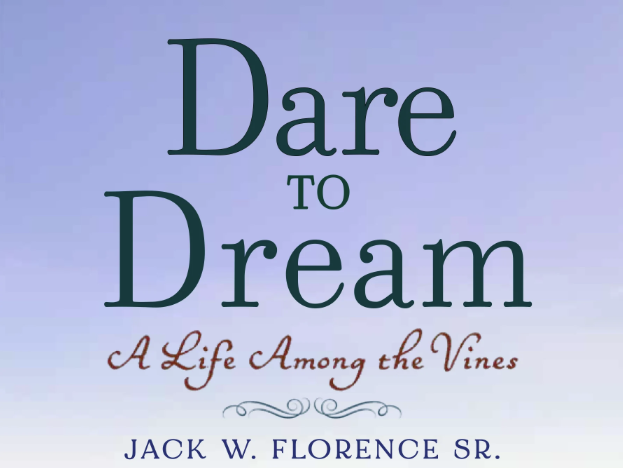Daring to Dream About a Life Among the Vines
By Virginie Boone
Jack Florence Sr. grew up on the streets of Manhattan, becoming a nuclear engineer during the height of America’s atomic energy days. In the 1970s and 1980s he worked for an engineering firm that designed and built oil refineries and chemical plants around the world. The job moved him to California and to a seemingly glamorous life of first-class business travel overseas, mostly to the Far East, from Indonesia to Japan.
But the glamour didn’t take away how much he missed his family when he was on the road, nor did it temper the dream he had long had in his head of growing wine grapes.
“Our first visit to wine country took my breath away. Standing by the road at the edge of an anonymous vineyard, I was transfixed,” he recalls. “How does one explain it? There was no obvious beauty, no flowers with their enticing fragrance, just quiet order. Vine after vine, row upon row, just like they’ve always been… the vines stand in long unmoving rows just as their ancestors have done for eons past. For thousands of years it has been so. Perhaps their attraction is just that. A kind of space walk. To gaze at a vineyard is to exist in another time. Dare we think we could become a part of this?”
This is how Florence describes his monumental decision to trade in an international businessman’s life for a vineyard in Sonoma County in his newly published book, Dare To Dream: A Life Among the Vines.
“Poor is the man who hasn’t learned to dream,” he writes. “Dreams survive the ignominy of failure, lost love, the road not taken. Our dreamers live in northern California Wine Country.”
Florence writes of the early dreamers who came to California in the mid-1700s, the Spaniards of Alta California, the Russians and Alaskans who established a colony off the California coast, the Mexicans who explored from Napa and across the Mayacamas through Santa Rosa back to the San Francisco Presidio.
He details how Dry Creek’s first commercial winery was established in 1872 by George Bloch and Alex Colson and how by 1875 most Dry Creek farmers had planted wine grapes or would do so soon, mostly Zinfandel, maybe some Riesling. And that by 1880 Geyser Peak Winery would open, followed by Italian Swiss Colony in 1881. By 1883, Dry Creek area vineyards had totaled from just under 200 acres to over 800.
But then came phylloxera, Prohibition, the Great Depression, World War II – “the production of wine could wait.”
And wait it did. Until after all the depredations, beginning in the 1970s, consumption exploded.
“The beverage of kings and queens for thousands of years was a pleasant discovery for beer-drinking Americans, and that love affair with wine was about to blossom,” Florence writes. “Americans had come late to the party but now, 500 years after Columbus discovered their continent, the Americans would make their move, crude at first, but with finesse and sophistication in the end. Finally, a quarter century after the war, with a modern refrigerator and washer in the house and a new car in the garage, Americans were ready for wine.”
By 1976 so was Florence, who with his wife Fran, arrived in Dry Creek Valley to become a farmer, leaving behind the only life they had ever known, “a world of lights, shopping centers and crowded freeways.”
The late 1970s were a time of tremendous change in the California wine industry. Florence details the multiple forces that hit the wine industry at once in America at the time.
“Americans, a nation of beer drinkers, were beginning to appreciate wine. Their increasing demand would be joined by forces for change whirling half a world away in Europe as well as Washington D.C. where new label laws were being considered. These were not simple label tweaks, a whole new system of appellations came with the new laws.”
Florence calls this the beginning of the end: “generics were out, varietals would be in,” with new federal recognition of appellations and viticultural areas.
“BATF [Bureau of Alcohol, Tobacco and Firearms; now the TTB] recognized what was obvious to all: wine reflected the vineyard where the grapes were grown, and the grapes reflected the location of the vineyard. The latter was understood by the industry, but that understanding did not extend to the extraordinary way in which the grapes reflected the growing conditions at the vineyard. Vineyard location in fact was the single most important ingredient of the wine in the bottle and BATF wanted this information readily evident to the wine consumer. Vineyard location was of paramount importance to wine industries around the world. Now California was about to catch up.”
The new label laws took effect January 1, 1983. Dry Creek Valley was approved as its own American Viticultural Area soon after, August 4, 1983. By 1987, five more AVAs within Sonoma County were approved. In 2002, Florence would help establish the Rockpile AVA in conjunction with his son, Jack Jr., who planted Zinfandel in what would become Rockpile in the early 1990s.
There are shout-outs throughout the book to such friends and mentors as Dave Stare, Lou Preston, the late Kent Rosenblum and Carol Shelton, and ruminations and reminisces of a life well lived.
In the end, Florence is powerfully reflective.
“As the time draws nearer to pass my baton, I dare to dream. I remember the dreams that brought me to Dry Creek Valley five decades ago. Now those dreams have turned to memories. Three kids and their kids, triumphs and failed crops, the birth of Rockpile and the death of friends. I’ll take my leave now, doze a little, and dream my dreams of yesteryear.”
Florence’s Dare to Dream is a wonderful time capsule of the highs and lows and lows and highs of a winegrowing life in Sonoma County, with keen insight into the many facets that go into a life in wine.
Find out how to get the book at Board and Bench and be sure to tune in to The Good Stuff on KSRO on July 26 when Jack will join us in studio.
Image by: Board and Bench Publishing


